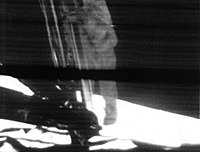Apollo Moon landings tapes reported missing
Correction — August 13, 2006
This article incorrectly reports that magnetic tapes of first moon landing and five other Apollo missions are missing. This is erroneous. Only the magnetic data tapes containing the recorded transmission from the moon's surface are missing. The data on these tapes includes the original slow-scan TV signals, plus voice and telemetry data of the first Apollo landing. The originally broadcast conversion of the slow-scan recordings of the landing are preserved at the National Archives.
The article also reports the Goddard centre is scheduled to be closed in October. This is incorrect. Only the Data Evaluation Laboratory at the Goddard centre is planned for closure.
Wikinews apologises for any confusion caused by these errors
See Also: Erroneous tabloid report garners publicity for Moon landing tapesSaturday, August 5, 2006

The magnetic tapes of the first moon landing that was beamed to the world via three tracking stations and those of other 5 Apollo missions have gone missing. There will be a search for these tapes in the hope that they may be found before they deteriorate.
The missing tapes contain original recordings of five Apollo Moon Landings. Due to the format incompatibility between the Apollo recordings and the commercial TV, the public transmissions were projected onto a screen from which they were filmed using conventional TV cameras which substantially degraded the quality of the picture. These were digitized and can be seen in the Apollo Lunar Surface Journal website, where all the graphic documentation of the Apollo Moon landings is maintained.
The tapes were originally stored at Goddard Space Flight Center, but, without any explanation, were taken to the US National Archives in 1970. A few years after, in 1984, about 700 hundred boxes of tapes were returned to Goddard along with documents stating that the tapes were withdrawn.
"We have the documents to say they were withdrawn, but no one knows exactly where they went," said John Sarkissian, a CSIRO scientist.
Mr. Sarkissian who has been working at the Parkes Observatory for more than decade, initiated a study about the participation of Australia in the Apollo Mission. He requested the tapes from NASA and they told him the tapes were missing.
"We are working on the assumption they still exist," Mr Sarkissian said, "Your guess is a good as mine as to where they are."
"People may have thought 'we have tapes of the moon walk, we don't need these',"
"We want the public to see the way the moon walk was meant to be seen,"
Mr Sarkissian proposes that if the tapes are found that they be digitised and stored.
The Goddard centre, home to the only known piece of equipment that decodes the analogue tapes, is set to be closed in October raising fears that, even if they are found, it might not be possible to decode and copy them.
Only a few people saw the original high-quality broadcast. One of these people is David Cooke, a Parkes control room engineer in 1969.
"I can still see the screen," Mr Cook, 74, said. "I was amazed, the quality was fairly good."
Sources
- Richard Macey. "One giant blunder for mankind: how NASA lost moon pictures" — The Sydney Morning Herald, August 5, 2006
- John Sarkissian. "The search for the Apollo 11 SSTV tapes" — CSIRO Parkes Observatory, May 21, 2006
| |
This page has been automatically archived by a robot, and is no longer publicly editable.
Got a correction? Add the template {{editprotected}} to the talk page along with your corrections, and it will be brought to the attention of the administrators. Please note that the listed sources may no longer be available online. |

